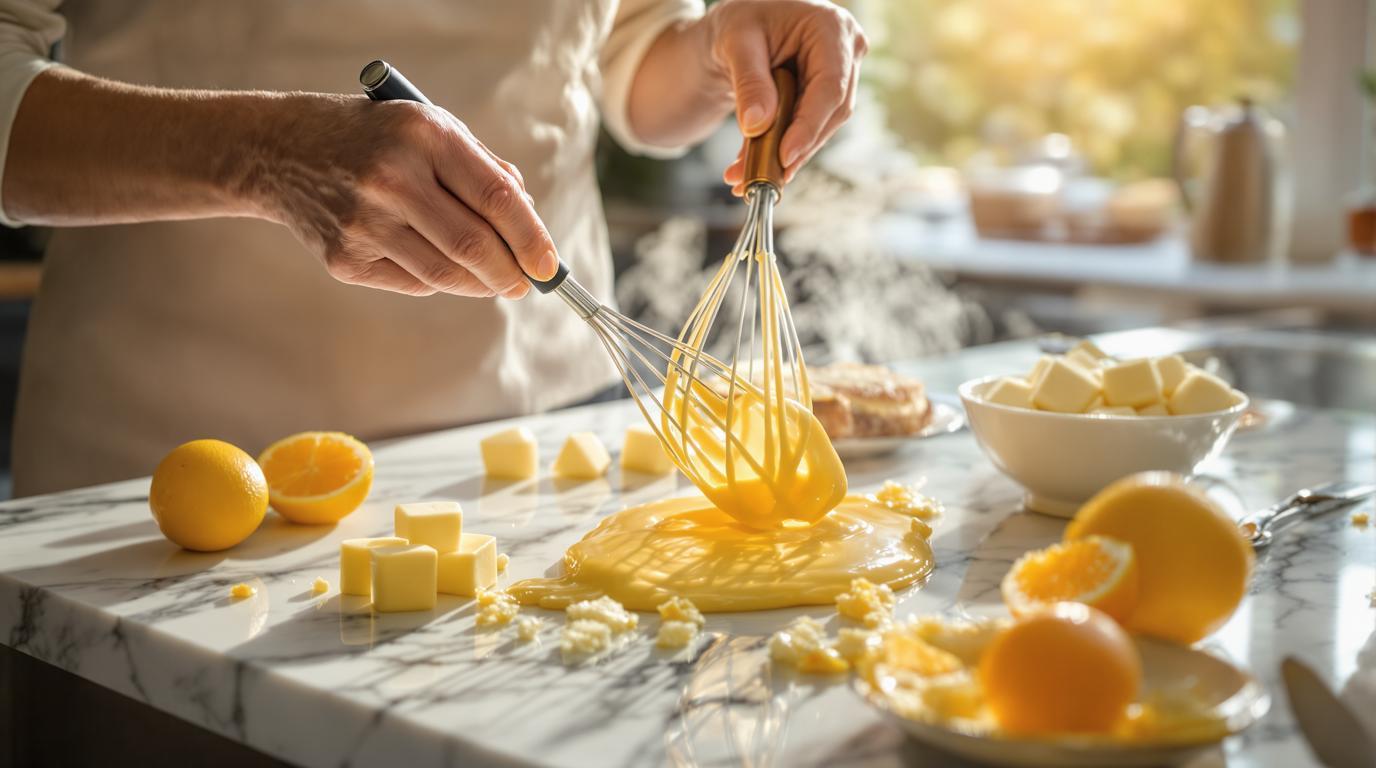There’s something magical about the first time you successfully make Hollandaise sauce from scratch. I’ll never forget standing beside my grandmother in her sunlit kitchen as she showed me how to whisk egg yolks into liquid gold. “The secret,” she’d say with a knowing smile, “isn’t just in the ingredients—it’s in the patience.” Today, I’m sharing my grandmother’s traditional Hollandaise recipe, the cornerstone of countless Sunday brunches and special celebrations in our family for generations.
The Delicate Art of Hollandaise 🇫🇷
Hollandaise sauce stands as one of the five mother sauces in classical French cuisine, dating back to the 17th century. Despite its prestigious reputation, this velvety emulsion of egg yolks, butter, and lemon juice remains one of the most intimidating sauces for home cooks. But fear not—with proper technique and a few chef’s secrets, you’ll master this culinary cornerstone that transforms everything from breakfast potatoes to steamed vegetables into elegant dishes.
Essential Ingredients for Perfect Hollandaise 🧈
For 4 generous servings, you’ll need:
- 3 large egg yolks (room temperature is non-negotiable)
- ½ cup (113g) unsalted butter
- 1½-2 tablespoons fresh lemon juice
- 1-2 tablespoons cold water
- ¼ teaspoon fine sea salt
- Pinch of cayenne pepper (optional but traditionally included)
Chef’s Note: The quality of your butter significantly impacts your final sauce. I recommend European-style butter with higher butterfat content for exceptional richness. If using regular butter, consider clarifying it first by melting slowly and skimming off the white milk solids for a silkier sauce.
The Traditional Method: Step by Step 🥄
- Prepare your workspace: Set up a small, heavy-bottomed saucepan or a double boiler. If using a double boiler, ensure the water simmers gently but doesn’t touch the bottom of the top bowl.
- Begin the emulsion: Combine egg yolks, 1 tablespoon lemon juice, 1 tablespoon cold water, and salt in your pan or bowl. Whisk vigorously until the mixture becomes pale and slightly thickened.
- Gentle heat application: Place over very low heat (or over simmering water if using a double boiler). Continue whisking constantly—this isn’t the moment to check your phone! The mixture should gradually warm and thicken.
- Test for readiness: After about 3-4 minutes of whisking, lift your whisk. The mixture should fall in ribbons and briefly hold its shape on the surface.
- Incorporate butter: Meanwhile, gently melt your butter until hot but not browned. Remove egg mixture from heat and begin adding hot butter a few drops at a time while whisking vigorously. As the emulsion forms, you can add butter in a thin, steady stream.
- Finish the sauce: Once all butter is incorporated, whisk in remaining lemon juice and cayenne to taste. The sauce should coat the back of a spoon and have a smooth, velvety consistency.
Troubleshooting Your Hollandaise 🧠
Even professional chefs occasionally break a Hollandaise. If your sauce separates (looks curdled or oily), don’t panic! Add 1 teaspoon of hot water and whisk vigorously off the heat. Still separated? Place a fresh egg yolk in a clean bowl, then slowly whisk in your broken sauce—this almost always salvages even the most hopeless-looking sauce.
For too-thick sauce, whisk in a few drops of warm water. For too-thin sauce, a few more seconds over gentle heat while whisking can help thicken it.
Perfect Pairings Beyond Eggs Benedict 🍽️
While Hollandaise is the crowning glory of classic breakfast dishes, its versatility extends far beyond brunch. Try it drizzled over:
- Steamed asparagus or artichokes
- Poached salmon or delicate white fish
- Roasted cauliflower steaks for an elevated vegetarian option
- Roasted vegetables as an unexpected but delightful pairing
For a complete meal that impresses, serve alongside hearty proteins and finish with something sweet.
Final Words of Encouragement 💫
Don’t be discouraged if your first attempt isn’t perfect—Hollandaise is as much about technique as ingredients. My grandmother always said, “A good sauce takes practice, but it’s worth every minute at the stove.” The day your whisk creates that perfect golden ribbon of sauce, you’ll understand why this technique has endured for centuries. Your kitchen will be filled with the buttery, lemony aroma that signals culinary success, and like me, you’ll be passing this recipe down through generations to come.
